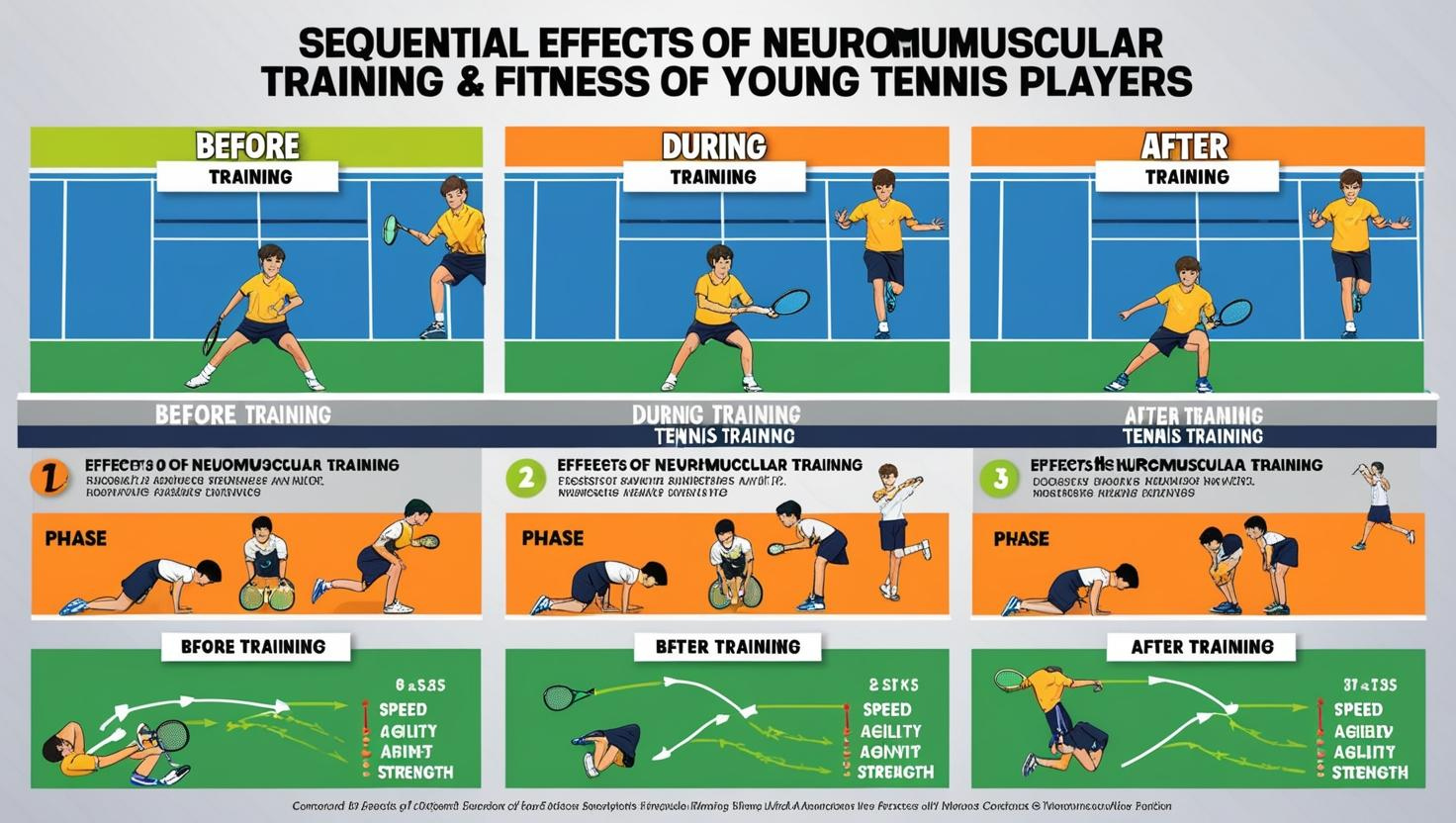Blog
Sequencing effects of neuromuscular training on physical fitness in youth elite tennis players

Introduction
The study “Sequencing Effects of Neuromuscular Training on Physical Fitness in Youth Elite Tennis Players” by Jaime Fernandez-Fernandez et al. examines the impact of neuromuscular training (NMT) timing within a training session on speed, agility, power, and overall physical fitness in young elite tennis players.
Tennis is characterized by high-intensity intermittent efforts, including rapid accelerations, decelerations, and changes of direction, all of which require a combination of speed, strength, and agility. Neuromuscular training (NMT) is widely used to improve these attributes, but the optimal placement of NMT within a training session remains unclear.
This study aimed to determine whether performing NMT before or after tennis-specific training influences physical performance outcomes.
Key Aspects of the Research
Study Design and Participants
The study recruited 16 male elite tennis players (mean age: 12.9 ± 0.4 years), all ranked among the top 200 in their respective national U14 category. Participants were assigned to one of two groups:
BT (Before Tennis Group): NMT was performed before tennis-specific training.
AT (After Tennis Group): NMT was performed after tennis-specific training.
The intervention lasted five weeks, with training occurring three times per week in addition to regular tennis practice.
Physical Performance Tests
Participants were evaluated in the following physical fitness components before and after the intervention:
Sprint Performance: 5m, 10m, and 20m sprints.
Agility: Modified 5-0-5 change-of-direction test.
Jumping Ability: Countermovement Jump (CMJ).
Upper-Body Power: Overhead Medicine Ball Throw (MBT).
Serve Velocity (SV): Maximum serve speed measurement.
Each test was conducted four days after the last training session to ensure proper recovery and avoid residual fatigue.
Key Findings and Performance Outcomes
Sprint Performance (5m, 10m, and 20m sprints)
- BT Group: Improvements in all sprint distances (5m: d = 0.52, 10m: d = 0.32, 20m: d = 1.08).
- AT Group: No improvements in 10m and 20m sprints, with a negative effect on the 5m sprint (d = -0.19).
Agility (5-0-5 Test)
- BT Group: Moderate improvement (d = 0.22).
- AT Group: Negative effect on agility performance (d = -0.24).
Jumping Ability (Countermovement Jump – CMJ)
- BT Group: Significant improvement in CMJ height (d = 0.29).
- AT Group: No significant changes.
Upper-Body Power (Medicine Ball Throw & Serve Velocity)
- BT Group:
- Medicine Ball Throw (MBT): d = 0.51
- Serve Velocity (SV): d = 0.32
- AT Group: No meaningful improvements in MBT or SV.
Summary of Results
The BT group consistently outperformed the AT group across all physical fitness measures, showing statistically significant improvements in speed, agility, jumping ability, and upper-body power. In contrast, the AT group showed trivial or negative changes, particularly in sprint and agility performance.
Physiological and Training Considerations
The differences in performance outcomes between groups are likely attributed to neuromuscular fatigue and training specificity.
1. Influence of Training Sequence on Neuromuscular Performance
- The BT group performed NMT in a non-fatigued state, maximizing the quality of movement, force production, and neuromuscular adaptations.
- The AT group completed NMT in a fatigued state due to prior tennis training, which may have compromised movement quality, force absorption, and power output.
2. Potential Fatigue-Induced Limitations in the AT Group
- Tennis training involves high-volume technical and tactical drills, which place stress on the muscular and nervous systems.
- Performing NMT after such training may have resulted in impaired power generation and reduced neuromuscular activation, limiting adaptation.
3. Implications for Strength and Conditioning Programs
- Performing NMT before sport-specific training appears to be the optimal strategy to improve key physical attributes in youth tennis players.
- Coaches should prioritize strength and power training in a fresh state, ensuring high-quality movement execution.
Conclusion and Practical Applications
This study provides strong evidence that the sequencing of neuromuscular training (NMT) within a training session plays a critical role in determining performance outcomes.
Key Takeaways:
✔ NMT performed before tennis training leads to greater improvements in sprinting, agility, and power.
✔ Training in a fatigued state does not yield the same benefits and may limit neuromuscular adaptations.
✔ Coaches should prioritize scheduling NMT in a fresh state to maximize performance gains.
Practical Recommendations for Coaches:
📌 Schedule NMT before technical/tactical sessions to ensure optimal neuromuscular activation and adaptation.
📌 Maintain structured session durations (20-40 minutes) as per the study’s methodology.
This research highlights the importance of optimal training sequencing in youth elite sports, providing a structured framework for improving performance through targeted neuromuscular adaptations.
Fernandez-Fernandez, J., de Villarreal, E. S., Sanz-Rivas, D., Sarabia, J. M., Moya, M., & Buchheit, M. (2016). Sequencing effects of neuromuscular training on physical fitness in youth elite tennis players. Journal of Strength and Conditioning Research, 30(1), 13-21.